Green Pest Control & Corporate Social Responsibility (CSR) by Pestlab Exterminator
In October 2021, Pestlab Exterminator received special recognition for outstanding performance in terms of Corporate Social and Responsibility (CSR) and Environmental Commitment by Eurocham Cambodia.
To confirm our intuition, in 2023, scientists discovered that these fumigations have been selecting a strain of super-insecticide-resistant mosquitoes in Cambodia that poses a lethal threat to public health. More than ever, this confirms ourselves in our own green culture.
A. Company description
A.1. History, size, growth, and geographical scope of operation
Pestlab Exterminator was founded in 2016 to implement Western standards in Cambodia, including the HACCP (Hazard Analysis and Critical Control Point) approach, IPM (Integrated Pest Management) guidelines, Corporate Social Responsibility (CSR), and eco-friendly solutions. The initial idea was to avoid thermal fogging, which is toxic and has a major impact on health and the environment.
In 2025, 20 people were employed by the company across its three branches: Siem Reap, Phnom Penh, and Kampot.
A.2. Main Products, Services
Today, our main activity is renting out and maintaining CO₂ mosquito traps developed by Biogents. We were the first company to introduce their mosquito solutions in Cambodia.
We also provide treatments for ants and cockroaches, producing and using our own nature-based insecticide gel. This gel is made from spinosad, a naturally produced toxin that has no impact on the environment and very limited toxicity for humans and pets. This reduces the environmental effects of our treatments as well as the hazards for our clients and applicators. A version of this gel is already available for individual consumers.
Pestlab Exterminator offers the full scope of green pest management, including:
- Mosquitoes
- Rodents
- Cockroaches
- Ants
- Flies
- Termites
- Hornets
- Bees (colony-friendly removal only)
Most of our key customers are involved in environmental conservation and/or hold green sustainability awards, face wildlife constraints, or possess an eco-certificate. They chose Pestlab Exterminator for our ability to combine high standards with sustainability.
- Jati Resort
- Jaya House River Park
- Knai Bang Chatt
- Koh Russey Villa
- La Plantation Kampot
- Shinta Mani Wild
- Songsaa Private Island
B. CSR and Green Activity Description
We have selected 6 examples of pest management solutions that we are the first (and most of the time still the only) Pest Control Operator (PCO) to implement in Cambodia. In red is indicated what was the usual practice of local PCOs when we started 5 years ago. In the meantime, other PCOs may have followed our innovation, for example regarding Biogents CO2 mosquito traps.
B.1 Biogents CO2 mosquito traps are a green way to manage mosquitoes
Usually, Pest Control Operators do mosquito control by using thermal fogging, which is the release of toxic smoke (based most of the time on diesel with added microparticles in it) with insecticide. This smoke is very bad against all the insects, including the useful ones, and also against any breathing animal (including humans).
At Pestlab Exterminator, we are the only pest control company that has never used any warm fogging machine in Cambodia. Indeed, this kind of technique is widely used in Asia and goes against our Green Core ethical values. Our current core business activity is the installation and maintenance of eco-friendly mosquito traps made in Germany by Biogents AG which works with CO2 and artificial human scents.
Biogents mosquito traps are the reference in the academic community of entomologists. The inventors have adapted their traps for individuals and Pest Control Operators. We were the first pest control operator to use these traps in Cambodia and we remain their main local partner. Also, we are working closely with them to adapt the traps to the local market (technically and in terms of design), to the endemic species (testing different lures depending on the species of mosquitoes in some particular areas), and to extend the use to endemic sandflies.
We are considered by Biogents AG (headquarters in Germany) as the reference partner Pest Control Operator (PCO) as we contribute the most in terms of feedback, field tests, and adaptation. We have contributed to the development of camouflage techniques for the traps, performance enhancement by combining the traps with other attractants (coconut husks), a combination of techniques to improve the performance (use of essential oil), test on other insects (see section B2. hereunder).
For example, these traps are involved in several sustainability projects that have already been put in place on several islands in the Maldives to create mosquito-free places. On these islands, the intensive use of insecticide fogging had severely destroyed the biodiversity (fauna and flora), whereas tiger/dengue/yellow fever mosquitoes had become “super-resistant” to insecticides. Using Integrated Mosquito Management techniques and Biogents traps has reduced the tiger mosquito population by 98% before the COVID-19 outbreak. Now they aren’t using any chemical fogging anymore on the island and the bio-diversity is being progressively restored.
We started working on a similar project before the Covid-19 outbreak. This project has been suspended, but we are confident that we will implement it once the tourist situation is back to normal, especially since we opened our Coastal area branch in Kampot earlier this year.
We are also developing new techniques combining several repellent essential oils and surfactants that we spray by misting (ULV) in hidden corners to chase mosquitoes from their usual resting place and push them into the mosquito trap.
UN Sustainable Development Goals for CSR: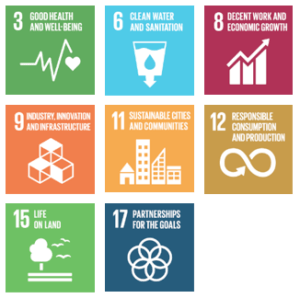
- Avoiding insecticides improves health and prevents water table pollution (3 & 6).
- Controlling vector disease mosquitoes improves health (3).
- Avoiding thermal fogging reduces work hazards for the PCO staff and for the staff of hotels (8).
- Contribution to the future development of eco-friendly traps in partnership with Biogents AG (9 +17).
- A network of traps in a district can make the area more sustainable, with less pollution due to fogging, more useful insects, and fewer diseases (11 + 15).
- The electric consumption of the mosquito trap is very low, only 4 watts (12).
B2. Adapting eco-friendly Biogents CO2 mosquito traps to sand flies
Beaches are a very fragile ecosystem. In some locations, these beaches are invaded by sand flies, which transforms these paradisiac places into hell.
Some PCOs have tried to eliminate sandflies by pouring a lot of insecticide on the beach, which is very polluting and this destroys an already fragile ecosystem. Moreover, this is ineffective in the medium term as the insecticides are quickly washed out and new sand flies can come after a few weeks.
That is why, in technical partnership with Biogents, we have adapted their mosquito trap to the sandflies trapping. Indeed, the basic mosquito trap is not genuinely adapted to the general conditions on a beach (salt, wind, heat, sand).
The catch rate is promising, the impact on other species is limited and the bites from sandflies on the beach are reduced.
 UN Sustainable Development Goals for CSR:
UN Sustainable Development Goals for CSR:
- Avoiding insecticides improves health (3).
- Controlling vector disease mosquitoes improves health (3).
- Avoiding thermal fogging reduces work hazards for the PCO staff and for the staff of hotels (8).
- Contributing to adapting the traps to sandflies in partnership with Biogents AG (9 +17).
- Avoid pouring liters of insecticide on the beaches which would have ended up in the sea (14).
- The electric consumption of the mosquito trap is very low, only 4 watts (12).
- While attracting sand flies, these traps continue to catch mosquitoes (2-in-1) and therefore avoid the fogging of the beach area (15).
B.3. Natural product-based insect gel as our green in-house production
Many PCOs use thermal fogging everywhere to get rid of ants, cockroaches, and other insects alike. More sophisticated PCOs who use insect gel, usually import gel from abroad. These gels are made of chemical insecticides and the applicant should have very strict training in order not to put the gel in potential contact with food. From experience, when importing these products, we are never sure about the seller and it happened that we received batches of fake gel with no active matter at all.
So, we have decided to produce our own ant & cockroach gel. To be safer and eco-friendly, we make it based on a natural product (Spinoad) used in organic agriculture. We combine it with only edible ingredients to make a palatable bait. Compared to professional insecticide gels that are imported, this gel is safer for humans & pets, and it is eco-friendly by nature. This green gel can be used by non-professionals.
“Spinosad, a highly selective, environmentally friendly insecticide made by a soil microorganism. It controls many chewing insect pests in cotton, trees, fruits, vegetables, turf, and ornamentals. Unlike traditional pesticides, it does not persist in the environment; it also has low toxicity to mammals and birds.” (US Environmental Protection Agency)
Usually, the insect gels are specialized either against ants or for cockroaches. Our innovation is to develop a bait that can attract ants and cockroaches alike. That way, we can use fewer products to protect an area at risk and limit wastage.
We already sell the gel for Eco-Cert certified farmers as spinosad is allowed in organic farms. The next step will be to bring this gel to the retail market. This allows individuals to fix their ant of cockroach problem without using chemical insecticides.
The plastic syringes that contain our gel are already systematically reused for the next batch of production.
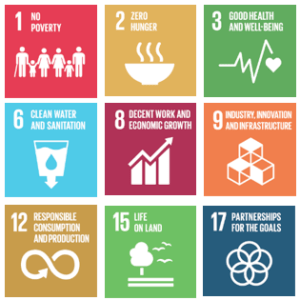 UN Sustainable Development Goals for CSR:
UN Sustainable Development Goals for CSR:
- Providing eco-friendly pest management products to farmers helps them to produce more organic food that generates higher income and therefore reduces poverty (1) and hunger while promoting sustainable agriculture (2).
- Controlling food-attracted insects avoids food spoilage (2).
- Avoiding chemical insecticides by supporting organic farming improves health, prevents water table pollution, and protects biodiversity (3, 6, 15 & 17).
- Using organic rather than chemical insecticide improves health (3) and reduces work hazards for farmers (8).
- Innovating (9) in creating the first recipe for a “2-in-1” ant & cockroach gel reduces gel consumption and waste (12).
- Avoid pouring liters of insecticide on the beaches which would have ended up in the sea (14).
- Using a 2-in-1 gel limits the quantity of product used and therefore wastage. We recycle/reuse the recipient of the gel (12).
B.4. Colony-safe bee removal as a corporate responsibility
Most of the time, local PCOs treat bees as pests and use the same treatment as for hornets or wasps. They simply spray the nest, killing all the colonies.
Our teams have been trained by a sustainable beekeeper for domesticating bees. And, when the species of bee cannot be domesticated, we use a green technique to gently remove the nest in a way that gives the colony the maximum chance to resettle somewhere else with the minimum loss. This technique is applied without any insecticide.
This service is provided at a cost price to support the bee population.
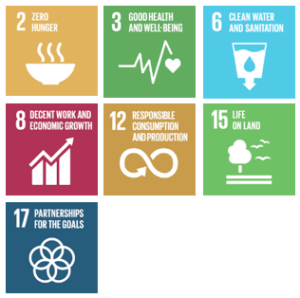 UN Sustainable Development Goals for CSR:
UN Sustainable Development Goals for CSR:
- Saving bee colonies by sustainable removal supports natural pollination that allows food to grow (2)
- Avoiding using insecticides improves the health of the staff (3 & 8), prevents water table pollution (6), and supports biodiversity (15).
- Intervention without consuming anything but dry leaves in the smoker (12).
- Partnership with a sustainable beekeeper (17).
B.5. Wild Life preservation as a CSR for rodent management
Usually, in Cambodia, rodent treatment is performed with mechanical traps, glue boards, or anticoagulant baits. Mechanical traps are not very effective. Furthermore, given the humidity, these traps get roasted very fast. Glue boards with the right attractant are effective against mice, but, as the rats are much cleverer than mice, only the use of baits is effective.
There are 2 main issues with the usual rodent treatment using anti-coagulant rodenticide:
- resistance to the active matter, and
- secondary poisoning of non-target animals.
For example, when snails eat the bait in the bait station and then are eaten by birds once the snail goes out of the bait station. The problem is that birds are extremely sensitive to the anticoagulant and a small quantity of product taken from secondary poisoning can be lethal. Furthermore, the effect of anticoagulant rodenticide is accumulative. Therefore, regular ingestion of the active matter, even in very small quantities, will be lethal in the long run.
Where wildlife needs to be protected, particularly birds, using anti-coagulant rodenticides is strictly forbidden. Therefore, using bait based on cholecalciferol (Vitamin D3) allows sustainable management of the rodent population and a complete reduction of the secondary poisoning of non-target wild animals as:
- most wildlife animals, in particular birds, cannot be poisoned with cholecalciferol, particularly at the secondary level,
- cholecalciferol is very soluble and does not accumulate in the organism in the long run like for the usual anticoagulants,
- since this is vitamin D3, this is even good for the health (increase immune system) of the wildlife animals that might be in primary or secondary contact with this type of bait.
Being able to offer eco-friendly and wild-life-friendly solutions is important for conservation projects and the sustainable development of eco-tourism.
Based on our feedback from a research scientist, using cholecalciferol in integrated pest management (outside specific cases like wildlife preservation, poultry farms, or academic research) is relatively new and not yet well-known by most PCOs, even in Western countries. So, on this part, we are even in advance on the common international standards.
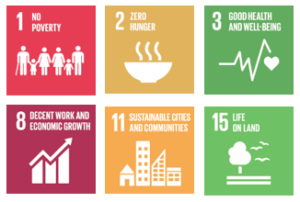 UN Sustainable Development Goals for CSR:
UN Sustainable Development Goals for CSR:
- Giving pest management services to develop sustainable exploitation of the National Parks and development of eco-tourism generates higher income and thus reduces poverty (1 & 8).
- Controlling rodents to avoid food spoilage (2).
- Avoiding anticoagulant rodenticides reduces the risk hazard for the applicant (3 & 8).
- Participating in the preservation of the natural heritage (11).
-
-
-
-
-
-
-
-
-
-
-
- Avoiding anticoagulant rodenticides eliminates the risk of secondary poisoning of wildlife animals (15).
-
-
-
-
-
-
-
-
-
-
-
B.6. Green insecticide-free elimination of bed bugs
Bed bugs incidences in Cambodia have resurged in recent years and their spread is due to the high amount of international travel and a lack of awareness. They are usually brought into buildings through luggage. Their flattened bodies allow them to conceal in the tiniest cracks and crevices around the room and within the furniture.
Usually, PCOs spray a cheap pyrethroid insecticide. Not only this generally doesn’t go deep enough into the crack, but, moreover, many strains are now pyrethroid-resistant, so usual insecticides are useless and only a professional pest controller can effectively fix this issue. And on top of that, insecticides act immediately and not on the eggs. So, when eggs hack 1 or 2 weeks later, this room becomes infested again. Thereafter, 2 months later the same treatment is renewed, for nothing, creating more pollution and more resistance among bedbugs. We have often seen clients asking for our service because the local PCO has already come 5 times and the problem remains.
In practice, we limit the use of insecticide against bed bugs, since many stains have become resistant to insecticide. Instead of insecticide treatments, we practice physical eradication, including professional vacuum cleaning, hot steam water, and diatomaceous earth in the treatment of bed bugs. Mechanical eradication is much healthier for applicants and clients. Afterward, we will apply an insect growth regulator (IGR) to all cracks, crevices, plinths, parquet flooring, baseboards, and all woodwork revealing gaps. IGRs are still chemical, but they are much less toxic than insecticides. They are used to avoid newly hatched bed bugs becoming adults and laying more eggs. IGR is remnant and non-repellant, which means it remains active against juvenile bed bugs several months after the treatment.
On top of that, we also sprayed Diatomaceous Earth inside cracks, joints of beds, and plinths to keep a longer and mechanical remnant effect.
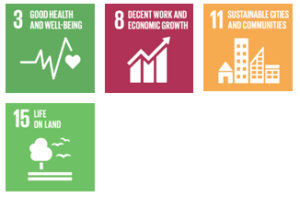 UN Sustainable Development Goal for CSR:
UN Sustainable Development Goal for CSR:
- Avoiding chemical insecticides rather than improves the health of the clients of the hotels that will use the room after (3) and reduces work hazards for the applicant (8).
- Avoiding insecticides makes the cities more sustainable (11), greener, and supports biodiversity (15).

